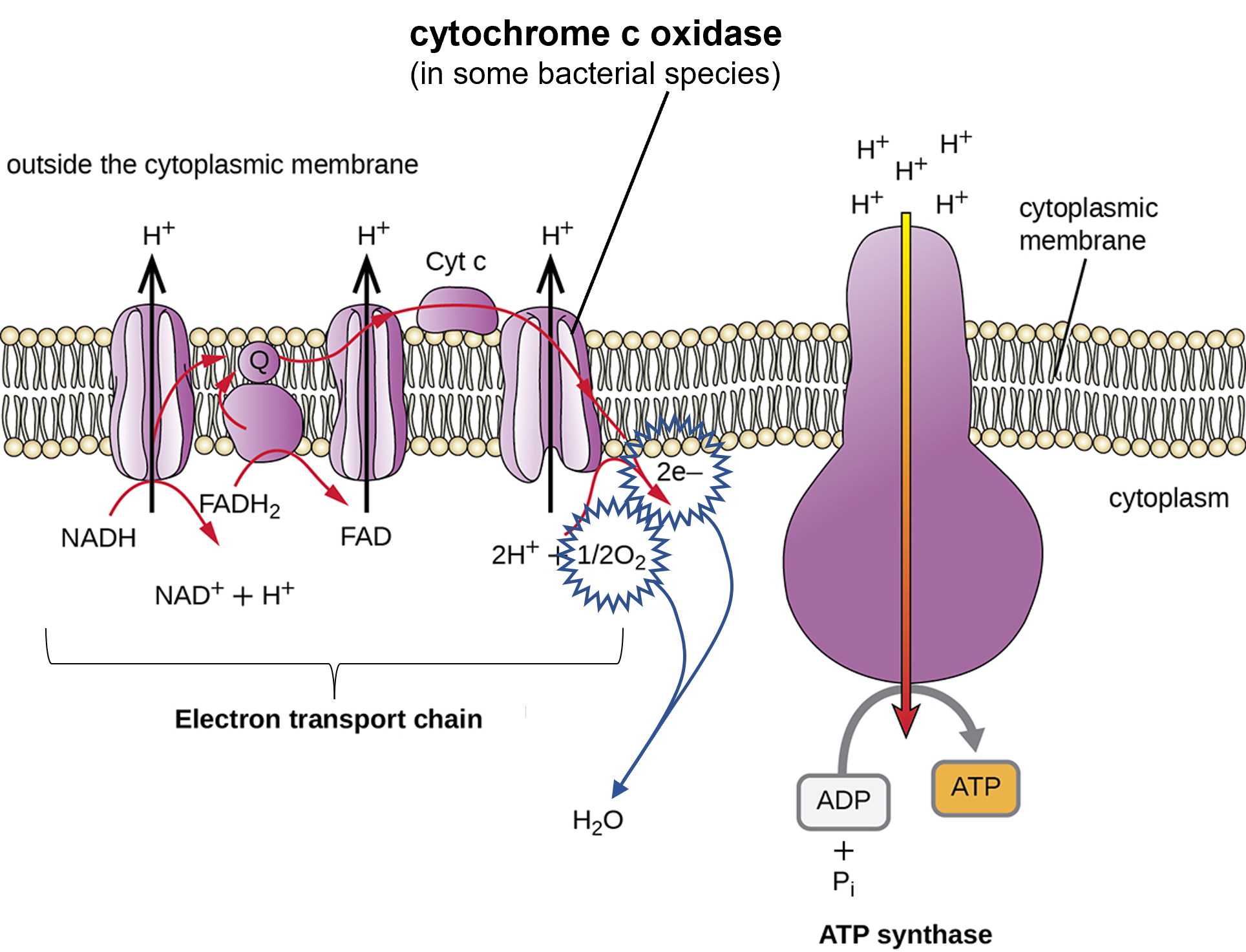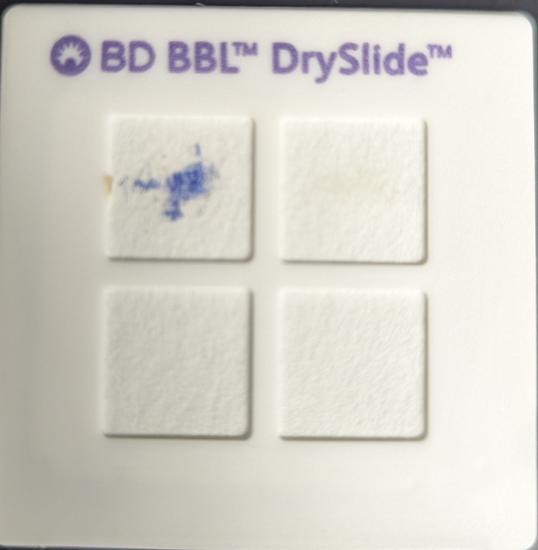10.1: Oxidase Test
- Page ID
- 132450
- Demonstrate an understanding of the principle behind the oxidase test, including the role of cytochrome c oxidase in the electron transport chain.
- Perform the oxidase test, including the inoculation of the test organism onto the oxidase reagent.
- Develop skills in interpreting the results of the oxidase test, including recognizing the color change indicating a positive or negative result.
- Understand the significance of the oxidase test in differentiating between bacteria that possess cytochrome c oxidase and those that do not.
- Correlate the results of the oxidase test with the biochemical characteristics and classification of microorganisms.
- Demonstrate proficiency in recording and reporting the results of the oxidase test accurately.
Cytochrome c Oxidase
Aerobic respiration is an O2-requiring process that uses energy from nutrient molecules to produce ATP molecules to provide for the cell's energy needs. During aerobic respiration, the electron transport chain transfers high-energy electrons from protein to protein and uses that energy to build up a H+ gradient that is utilized by ATP synthase to make ATP. At the end of the aerobic electron transport chain, an enzyme transfers the electron from the electron transport chain to O2. In some bacteria capable of aerobic respiration, that enzyme that transfers electrons to O2, the final electron acceptor for aerobic respiration, is called cytochrome c oxidase. (Fig.1.)

Figure 1: The bacterial electron transport chain is a series of protein complexes, electron carriers, and ion pumps that are used to pump H+ out of the bacterial cytoplasm into the extracellular space. The last enzyme in the electron transport chain can be (depending on the species) cytochrome c oxidase. The role cytochrome c oxidase plays is to remove electrons from the chain by transferring them to O2 with H+ to produce water. In aerobic bacterial species that do not have cytochrome c oxidase, this process still occurs, but using an enzyme that has a different structure and different name than cytochrome c oxidase. The gradient of H+ produced by the electron transport chain is used by the ATP synthase to make ATP. H+ flows back down the electrochemical gradient into the bacterial cytoplasm through ATP synthase, providing the energy for ATP production by oxidative phosphorylation (credit: modification of work by Klaus Hoffmeier).
A test called the oxidase test can be used in the laboratory to determine if a bacterial species has cytochrome c oxidase. Those species that have cytochrome c oxidase are called oxidase positive and those species that do not have cytochrome c oxidase are called oxidase negative. The ability of a bacterial species to produce cytochrome c oxidase is coded in its DNA. If the cytochrome c oxidase gene is present in the bacterial species, it will produce this enzyme. If the gene is absent, that bacterial species cannot produce cytochrome c oxidase. The oxidase test is therefore useful for characterizing bacterial species and differentiating bacterial species from each other for identification purposes. For example, the gram-negative opportunist Pseudomonas aeruginosa and the gram-negative cholera-causing Vibrio cholerae use cytochrome c oxidase, which can be detected by the oxidase test, whereas other gram-negative Enterobacteriaceae, like E. coli, are negative for this test because they produce different cytochrome oxidase types.
Bacterial species that contain cytochrome c oxidase are capable of aerobic respiration. Oxidase-positive bacterial species are all aerobic.
However, oxidase-negative species are not necessarily anaerobic. Oxidase-negative species may still be aerobic species or facultative anaerobes, but they produce and use a different enzyme, other than cytochrome c oxidase, to transfer electrons from the electron transport chain to O2.
The Oxidase Test
The oxidase test is a key test to differentiate between the bacterial families Pseudomonadaceae (oxidase positive species) and Enterobacteriaceae (oxidase negative species).
The oxidase test utilizes a special reagent called an oxidase reagent. This reagent is colorless. However, in the presence of cytochrome c oxidase, the oxidase reagent will transfer its electrons to cytochrome c oxidase and exhibit a bluish or purplish color in 30 seconds or less. (Fig.2.)
- oxidase-positive bacteria contain cytochrome c oxidase and produce a change in color of the reagent from colorless to bluish or purplish in less than 30 seconds.
- oxidase-negative bacteria do not contain cytochrome c oxidase and do not change the color of the oxidase reagent in less than 30 seconds.

Figure 2: An oxidase test strip containing oxidase reagent is still white indicating bacteria is oxidase negative (left). The oxidase test strip containing the oxidase reagent is purple indicating the bacteria are oxidase-positive (right).
Laboratory Instructions
Oxidase Test
- Obtain an oxidase DrySlide.
- Using a toothpick, add a sample of each species into separate panels of the DrySlide.
- Start a timer for 30 seconds.
- Watch for purple color to develop on the oxidase test strip within 30 seconds.
- purple or bluish color change in less than 30 seconds is oxidase positive
- no color change within 30 seconds is oxidase negative (color change after 30 seconds is considered oxidase negative)
- Repeat for each bacterial species you are testing.
Attributions
- "Microbiology Laboratory Manual: Labs, 1.19 Cytochrome C Oxidase" by Dr. Rosanna Hartline, West Hills College Lemoore, LibreTexts: Biology is licensed under CC BY-NC 4.0
- Chapter Image: Red Mountain Microbiology by Jill Raymond Ph.D.; Graham Boorse, Ph.D.; and Anne Mason M.S. is licensed under CC BY-NC 4.0
- MB352 General Microbiology Laboratory 2021 (Lee) by Alice_Lee@ncsu.edu is licensed under CC BY-NC-SA 4.0
- Microbiology by OpenStax is licensed under CC BY 4.0
- Red Mountain Microbiology by Jill Raymond Ph.D.; Graham Boorse, Ph.D.; Anne Mason M.S. is licensed under CC BY-NC 4.0

